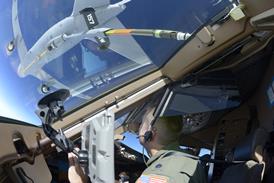Andrzej Jeziorski/MUNICH
Germany's RAM-System is developing a surface-to-surface mode for its Rolling Airframe Missile (RAM), designed for close-in air defence of ships, which will allow attacks to be made on small surface vessels.
According to prime contractor RAM-System - a joint venture between Bodenseewerk Gerätetechnik (BGT), its parent Diehl and Daimler-Benz Aerospace (Dasa) - the capability will be available in two years' time.
The first two prototype missiles featuring the new mode are under construction, and the upgraded system should be fitted to German navy F124 frigates from 2000.
"The surface mode will give RAM a capability against the entire range of targets: anti-ship missiles, aircraft, helicopters and small surface vessels, "says RAM-System. The modification requires new software for the launching ship's combat direction system.
The RAM is guided by a dual-mode passive radio frequency/ infrared (RF/IR) seeker and has an intercept range of 10km (6 miles). In countering active radar-guided anti-ship missiles, the passive RF seeker locks on to the target following missile launch after which the IR seeker takes over for terminal engagement.
The manufacturer reports a 95% success rate in about 100 test firings up to the end of last year.
RAM-System says it is now developing an improved imaging IR seeker together with US partner Raytheon.
This will give the missile an "IR all-the-way" capability against non-radiating targets. The first of the improved seekers should be produced this year, and will be retrofitted on all RAM systems in the German and US navies from the year 2000.
The company is also developing an 11-round launcher - which is smaller than the standard 21-round unit - which would be preferred on some US Navy vessels because a lighter launcher is required for stability .
Source: Flight International




















